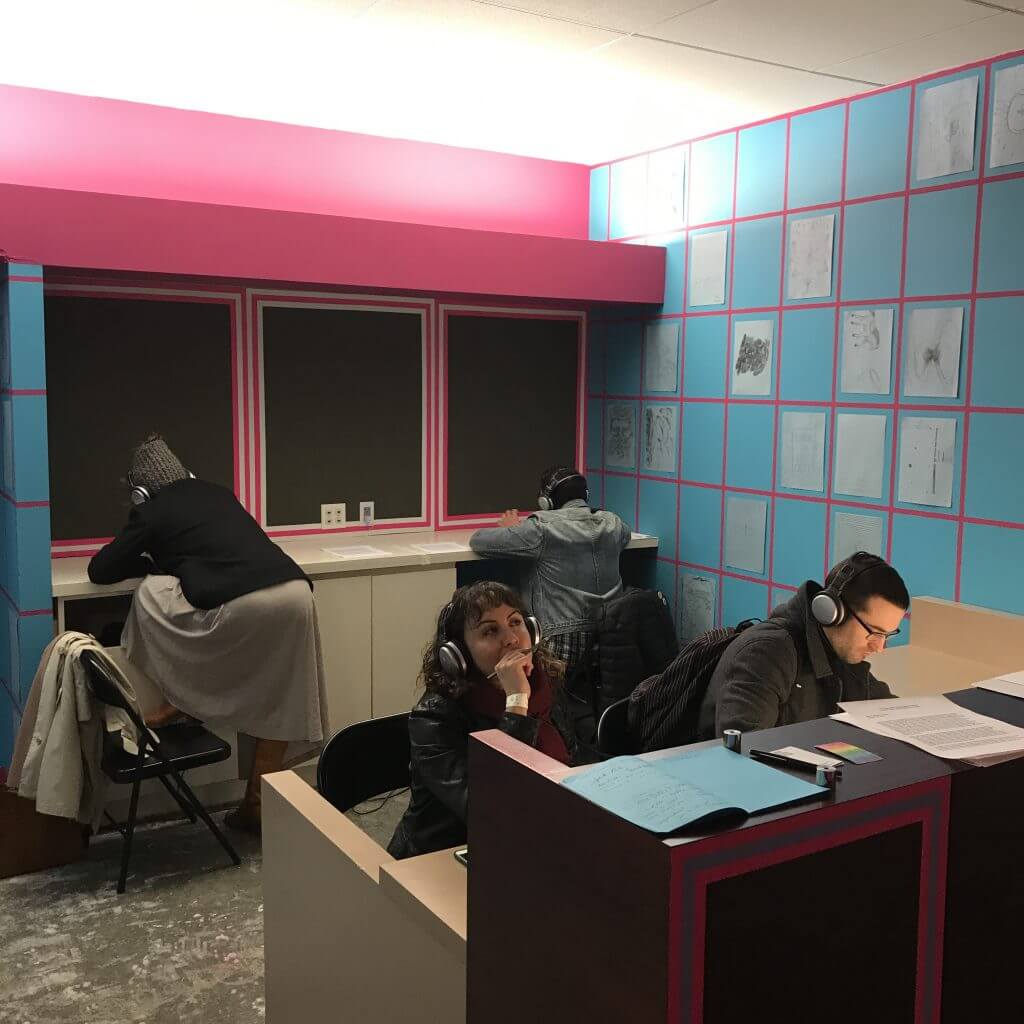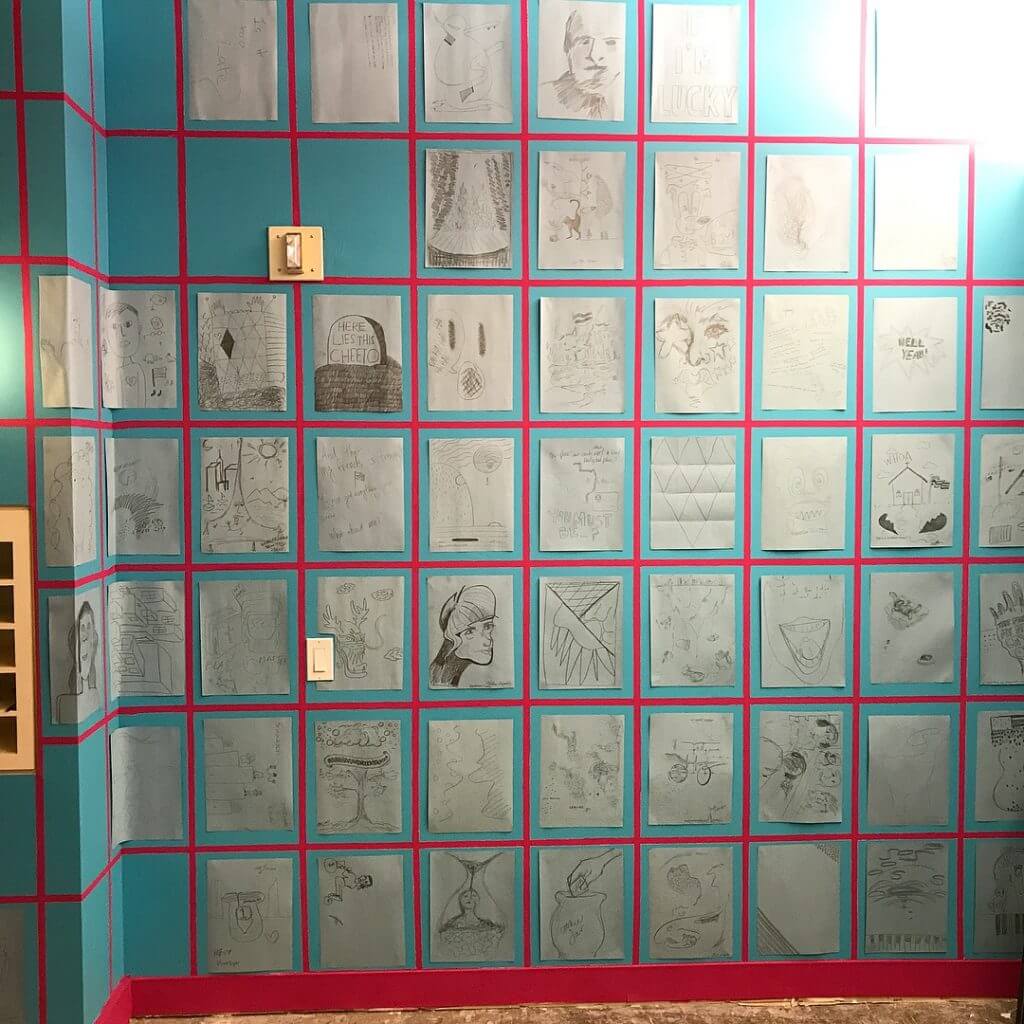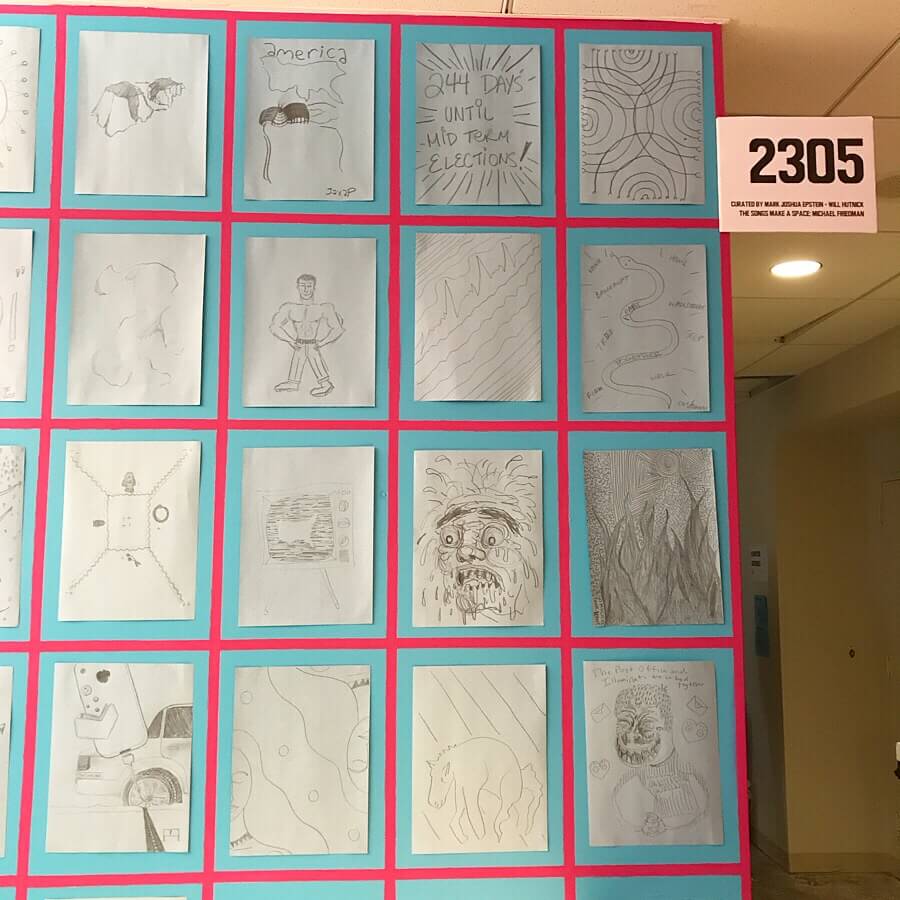Will Hutnick and Mark Joshua Epstein at SPRING/BREAK Art Show

 The SPRING/BREAK Art Show is always a refreshing stop on the “NYC Armory week” circuit. The least commercial of the fairs, SPRING/BREAK is the cool little cousin of the big fairs–the one that doesn’t give a shit about what collectors expect to see–or at least, that’s the vibe. This year, artists and curators addressed the theme, “Stranger Comes to Town.” Since many of the rooms are curator-driven, there is usually a strong position represented in each. Entering a room can feel like walking into someone’s brain–each space holds its own impassioned conversation within a larger chorus of perspectives on the year’s theme. This intensity, in combination with trendy maximalist presentation styles, and a labyrinthine layout (“How the hell did I get in here, and how do I get out?!?”), are beloved hallmarks of the SPRING/BREAK experience.
The SPRING/BREAK Art Show is always a refreshing stop on the “NYC Armory week” circuit. The least commercial of the fairs, SPRING/BREAK is the cool little cousin of the big fairs–the one that doesn’t give a shit about what collectors expect to see–or at least, that’s the vibe. This year, artists and curators addressed the theme, “Stranger Comes to Town.” Since many of the rooms are curator-driven, there is usually a strong position represented in each. Entering a room can feel like walking into someone’s brain–each space holds its own impassioned conversation within a larger chorus of perspectives on the year’s theme. This intensity, in combination with trendy maximalist presentation styles, and a labyrinthine layout (“How the hell did I get in here, and how do I get out?!?”), are beloved hallmarks of the SPRING/BREAK experience.
Will Hutnick and Mark Joshua Epstein wanted their room to be different. Talented painters in their own right, this is their second year co-curating a SPRING/BREAK booth showcasing the work of others. This year’s project, “The Songs Makes a Space,” offered visitors a chance to withdraw from the chaos to sit, listen, and reflect. Comfy headphones piped in selected songs from composer/lyricist Michael Friedman’s project “The State of the Union Songbook”, a song cycle created during the most recent presidential primary season in collaboration with WNYC and the New Yorker Radio Hour. The funny, sincere, and deeply affecting songs are stitched together from direct quotes from interviews that Friedman did with voters in several primary states. The perspectives represented are diverse, and unflinchingly honest. Friedman, who identified as gay and Jewish, and came from the East Coast, was an outsider in many of the places he visited, but he managed to connect simply by being open to listening. He died of AIDS-related complications at the age of 41 in September 2017.
“The Songs Makes a Space,” was a deeply generous and generative space–an homage to Friedman and the spirit of his project, and also to the power of listening, and the value of stepping aside sometimes to let others do the talking. Over the course of the fair’s run, the booth’s walls, which began as an empty painted grid, filled up with drawings that visitors were invited to work on while they sat listening to Friedman’s songs. I was really touched by the presentation, especially the way that it seems to infinitely reflect the radical, even countercultural act of making space rather than taking it up. I wanted to hear more about Will and Mark’s decision to feature this work, their experience at the fair, and their thoughts on the role of curation in the contemporary art world. Here is the conversation that resulted:

Which came first–the idea for a SPRING/BREAK booth that wasn’t built around visual art, or the desire to showcase Michael Friedman’s work? Tell me a bit about how the project evolved.
Mark: When the New Yorker Radio Hour started to premiere Michael Friedman’s songs from “The State of the Union Songbook” project in 2016, I was often in my studio and I remember keying into the lyrics and thinking that this person who I so identified with, who demographically was not too dissimilar from me–gay, Jewish, from the east coast–was creating something extraordinary. I had a hunch that other artists would respond to the songs as well because they’re so full of visual details.. Not long after, SPRING/BREAK announced that it’s curatorial theme was “Stranger Comes to Town” and the puzzle clicked into place. It seemed like a natural way to highlight these songs.
The discussion with Will about the project was also really important. I brought him this half-formed idea and together we spent a few weeks figuring out how to make the whole thing work. I remember being upstairs at Beverly’s–I had reached out to Will for help painting a wall panel for a show there–and Leah Dixon overheard us going back and forth about how this Michael Friedman project might look and function, and she was the first one who said that she didn’t think the space needed much more than the music.

It was then a matter of reaching out to people at the New Yorker and WNYC to facilitate getting permission to use Michael Friedman’s songs and asking the radio station to release the sound files to us. This was a project that involved a lot of quick learning for both Will and myself– we had never had to liaise with a publication before in order to do a show.
This is your second time working together as curators, and I believe you met when you were invited to collaborate on an installation at DEMO Project in Springfield, IL. How is curating together different from making work together, and how is it similar? Where do your practices and interests intersect, and where do they diverge to create something new?
Will: This is actually our third time working collaboratively together with a curatorial project (the second time at SPRING/BREAK though) – the first was at Trestle Projects in Gowanus in 2015 with an exhibition called OVERRIPE, featuring the work of Inna Babaeva, Rachel Klinghoffer and others. We met in 2014 or 2015 because I was a fan of Mark’s work so I reached out to see if I could come over to his studio, and we immediately connected. Our first non-curatorial project was in early 2016 at DEMO Project called Excavators in which we painted all of the interior walls of the gallery in a kaleidoscopic cacophony of abstraction to ultimately investigate the history of the space. What if certain shapes, patterns and colors were inherent in the walls and underneath all the white walls of the gallery, pulsing to let loose? DEMO was a really special and generous project where we got to cover the fireplace, all the walls, columns, the radiator, with paint and had tremendous support from the Directors there. We were excited to be invited back to DEMO this past January (2018) to paint one of the exterior walls of the building before the entire structure was demolished.
I don’t think that our collaborative work is that dissimilar to our curatorial projects together. There’s a consistent ethos of honesty and vulnerability to draw out and facilitate the strengths in the other person, and to negotiate for support. I think we work well together because we trust one another and therefore don’t have to micromanage every decision. We had an unofficial rule during our first project at DEMO to not treat any mark/shape/color/form/whatever as precious; that potentially the other person could paint over your individual work at any given moment. There is something really exciting, terrifying and liberating in that approach, and I think it works well because of the trust and respect that we have for one another.
Mark: I think that the fact that we share some visual vocabulary both in our studio practices and our curatorial interests is important, but also that we diverge all the time is the key to us working together successfully. We are both pretty strong willed when it counts but we are also very willing to compromise when it’s clear that a decision might mean more to the other person.
I know a lot of friends tend to stop by the booths at SPRING/BREAK, but tell me about some interactions you had with strangers. Was there anything that surprised you and/or inspired you during your time at the fair?
Will: That was probably my favorite part of SPRING/BREAK and our space: corralling people to come in, sit down and listen. It’s harder than it seems considering SPRING/BREAK is super bonkers, but I was pleasantly surprised with the amount of people that took the time to do so. Most people were really excited about the project and wanted to participate, and because we had two separate listening stations set up, two people could listen to one song together, and laugh and/or cry together, create together. I don’t think I anticipated how generous the project would be, that it offered some glimpse into one individual’s personality and narrative (the interviewee), flaws and all. We talked to a lot of people who would like to ideally see another iteration of this project in the near future, so I’m feeling really inspired to figure out what that would look like: can we have musicians playing live music? Are the drawings that were created at SPRING/BREAK projected onto the walls? Is new work being created? How else can visitors participate? The possibilities are exciting and overwhelming.

Mark: I would change my pitch constantly to try and get people to put the headphones on, because I saw that if someone agreed to listen for two seconds, they would often stay much longer. Watching people’s faces as they listened and as they picked up a pencil to draw, reminded me so much of how I had felt in my studio listening to these songs. You have an expression on your face that shows intense disagreement with whatever you’re hearing, and then for a moment it all shifts and there’s empathy with even just a tiny detail of someone’s life. Each song is so complicated, as I am sure each interview was–and the nuances are many–so it was really gratifying to watch people take the time to engage. I remember two people who were friends put headphones and were listening to the song “Student Debt”, which is sung by Kristolyn Lloyd. They just kept looking at one another and smiling and at the end took off their headphones and one of them said “This is ME, this is exactly my story”.
Do you have a favorite song, or moment in a song, that you’d like to share here?
Mark: There are too many. There’s a lyric in one of the songs that goes “I’m a midwestern boy, Quincy, Illinois” and I always marvel at how a few words from someone’s interview became this perfect rhyming lyric. That moment just sends the songs into another realm for me.
Will: I love that one of the songs ends with “If you buy in bulk, you must be American”, which is just hilarious and has a nice bite to it. There’s also a song in which the interviewee thanks God for bringing Michael into his life, which is just so sweet and sad.
“The Songs Makes a Space” really highlighted a positive aspect of the recent rise of the artist-as-curator, which is that it has played a huge role in bringing marginalized voices and perspectives into the art world conversation. Tell me more about the decision to ask visitors to contribute drawings, and how this act might relate to the overall valuation of inclusiveness in the art world.
Will: What is most special about Michael Friedman’s project “The State of the Union Songbook” is how democratic and empathetic it is. It’s a cast of people with different racial identities, socio-economic statuses, locations, political values, you name it, so I think that we wanted to create a similarly open, flexible and inclusive space. And just as Michael is able to let people be themselves and say what’s on their mind, we wanted to create a space where people could respond to the music however they see fit, and those creations would become a part of the actual space; that equal value would be placed on all drawings or responses created because they are all valid.
Mark: I think it’s also important to say the pool we were drawing from at SPRING/BREAK is in some ways pretty rarified–so while it’s good to highlight that we gave people the opportunity to respond, the range of opinions that seemed evident in the works on the wall were not hugely divergent from one another. I wonder how things would turn out in another context, when perhaps there might be more conservative opinions on display.
Friedman’s songs and the visitors drawings both originate in the American vernacular. The “likes” and “ums” so often heard in everyday speech are retained in the song lyrics, and might have their visual equivalent in the doodles and drawings that people made in response to the recordings. Do you think this played a role in visitors’ willingness to engage when they came into the space?
Mark: There are multiple versions of the songs we chose–and we went for the ones from a concert Michael Friedman did at the Jerome L Greene space, when some of the songs were still very new. I love those idiosyncrasies that pop up in people’s language, and the concert–I think even more than some of the later versions of the songs, highlights those because there’s also such a vulnerability with Michael himself in the singing and the playing, he definitely slips up on a lyric now and then. In the introduction to one song I think he says that he wrote it the day before–so it was all pretty new.
Will: That is a good observation. What really got me hooked on Michael’s work is the “likes” and “ums” and the awkward pauses and phrases from people – because I for one am super self-conscious about the way I speak and present myself to the world, so it’s very refreshing to see and hear those anxieties, imperfections, those basic human qualities, in others, especially presented in this unique musical format.
I really admire the generous spirit of the space you created at SPRING/BREAK. Were there any moments when you questioned the decision to use the opportunity for exposure in this way? How do you think this experience will impact your individual practices and/or the way you work together in the future?
Will: From the get go, I think there were so many doubts about the project – namely, WHO are WE to be doing this? What gives us the right to use Michael’s music? Do we have that right? A lot of visitors at SPRING/BREAK asked us if we knew Michael personally, which we didn’t, and I couldn’t help but feel a little guilty about that. I am so enthusiastic that this actually came to fruition and that Mark guided this project along and poked me until I said that I would participate with him. I think that it has been a very rewarding and rich experience that really pushed me out of my comfort zone, and I hope that this opens the door for more curatorial and non-curatorial projects that are engaging, respectful and diverse.
Mark: During SPRING/BREAK’s VIP preview no one stopped to listen or to draw and I remember thinking to myself, eek, we’ve totally pitched this project in the wrong way. But as soon as VIP hours were over and people were there not so much as collectors but as visitors to a show, everything shifted and people started to put the headphones on and make some drawings. I don’t think I foresaw quite how much interaction Will and I will would need to have with visitors in order to explain the project, so that amount of talking was a lot to endure some days. I also come from an informal education background in addition to my studio practice, so giving people an opportunity to engage with works using art-making, is very natural to me–and trying to start conversation to deepen the understanding of an artwork is very much what I’m about in my teaching life. In that way this is maybe the first curatorial project that felt very much in line with the values I hold in other parts of my professional life.
Any plans future collaborations in the works?
Mark: It’s never too long before one of us ropes the other into something. And I feel like even when we aren’t officially collaborating on a project, there is an open dialog about studio work, jpegs of paintings in progress being texted back and forth. Will is also an accomplished cellist and we’re both musical theater nerds, so I wouldn’t be surprised if music popped up again somehow in a project in the future.
Will: We’re hoping to ideally create another site-responsive work at a space in the near future. I think we’re definitely open to whatever comes next collaboratively, and in the meantime will support each other on our individual practices.
Responses